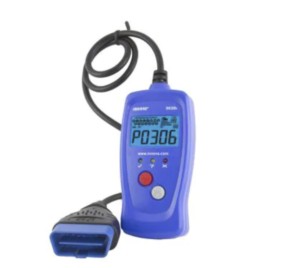The Check Engine light on your dashboard can be alarming, and deciphering the trouble codes can feel like reading a foreign language. If you’ve encountered the OBD-II code P0456, you’re likely dealing with a “small evap leak.” While it might sound minor, understanding and addressing this issue promptly is crucial for your vehicle’s health and the environment. This guide will walk you through understanding, diagnosing, and fixing code P0456, empowering you to tackle this repair effectively.
Understanding the P0456 Code and Your Vehicle’s EVAP System
Code P0456 points to a problem within your vehicle’s Evaporative Emission Control System (EVAP). This system is designed to prevent harmful fuel vapors from escaping into the atmosphere. Instead of venting these vapors, the EVAP system captures them and stores them in a charcoal canister until the engine can safely burn them off.
[  OBD-II code reader tool used to diagnose car problems
OBD-II code reader tool used to diagnose car problems
Buy Now ](https://www.autozone.com/test-scan-and-specialty-tools/code-reader?intcmp=BLG:BDY:1:20230109:00000000:GEN:trouble-codes)
The powertrain control module (PCM) diligently monitors the EVAP system for leaks. It does this by pressurizing the fuel tank and system and checking for pressure drops. Code P0456 is triggered when the PCM detects a very small leak in this system, indicating that fuel vapors are escaping where they shouldn’t. This leak is often so small that it might not be immediately obvious, but it’s still enough to fail the system’s integrity test and illuminate your check engine light.
Symptoms of Code P0456: What to Look For
One of the frustrating aspects of code P0456 is that it often presents with minimal noticeable symptoms beyond the illuminated check engine light. You might not experience any significant changes in your vehicle’s performance. However, some subtle signs could indicate a P0456 code:
- Check Engine Light: This is the most common and often the first symptom. The light will illuminate on your dashboard to alert you to a potential issue.
- Faint Fuel Odor: In some cases, especially if the leak is slightly larger or near the fuel tank, you might detect a faint smell of gasoline, particularly after parking your car in a garage or enclosed space.
- Slight Decrease in Fuel Economy: A very minor decrease in fuel efficiency might occur over time as fuel vapors are escaping instead of being burned by the engine. This symptom is usually very subtle and hard to attribute solely to a P0456 code.
While these symptoms may seem insignificant, it’s important to address code P0456. Even small EVAP leaks contribute to air pollution and can potentially worsen over time, leading to more significant issues and potentially failing emissions tests.
Diagnosing the Cause of P0456: Step-by-Step
Pinpointing the exact cause of a P0456 code can sometimes be a process of elimination, as many components in the EVAP system could be responsible for a small leak. Here’s a step-by-step approach to diagnosing the issue:
-
Check Your Gas Cap: This is the easiest and most frequent culprit. A loose, cracked, or improperly sealing gas cap is a common cause of small EVAP leaks.
- Action: Remove and reinstall your gas cap, ensuring it clicks tightly into place. Inspect the gas cap for any cracks or damage to the rubber seal. If it looks worn or damaged, consider replacing it.
-
Inspect EVAP System Hoses and Lines: Carefully examine all the hoses and lines connected to the EVAP system, including those near the fuel tank, charcoal canister, and engine compartment.
- Action: Look for any signs of cracks, rot, or disconnection. Pay close attention to areas where hoses connect to components. Feel the hoses for brittleness or softness, which can indicate degradation.
-
Examine the Charcoal Canister: The charcoal canister stores fuel vapors. Cracks or damage to the canister itself can lead to leaks.
- Action: Visually inspect the canister for any cracks or physical damage. Also, check the hoses connected to the canister for proper connection and condition.
-
Check the Purge Valve and Vent Valve: The purge valve and vent valve are solenoids that control the flow of vapors within the EVAP system. A malfunctioning or leaking valve can cause a P0456 code.
- Action: Listen for any clicking sounds from these valves when the engine is running, which could indicate they are functioning. However, a more thorough check might require professional diagnostic tools or a smoke test. You can find replacement purge solenoids and purge valves at auto parts stores if you suspect these components.
-
Consider a Smoke Test: For pinpointing small leaks that are difficult to find visually, a smoke test is highly effective. This involves using a smoke machine to introduce smoke into the EVAP system and observing where smoke escapes, indicating the leak’s location.
- Action: While you can purchase DIY smoke machines, this test is often best performed by a professional technician who has experience with EVAP systems.
Step-by-Step Guide: How to Fix Code P0456 Yourself
Once you’ve diagnosed the likely cause of your P0456 code, you can proceed with the repair. Here’s how to fix code P0456 based on common causes:
-
Fix a Loose or Damaged Gas Cap:
- Solution: If the gas cap was loose, simply tighten it securely. If the gas cap is cracked or the seal is damaged, replace it with a new one. This is an inexpensive and often effective fix.
-
Replace Damaged EVAP Hoses or Lines:
- Solution: If you find cracked, rotted, or disconnected hoses, replace them. You can purchase replacement hoses at auto parts stores. Ensure you use hoses of the correct type and diameter for the EVAP system. Cut the damaged section and replace it with the new hose, securing it tightly with hose clamps if necessary.
-
Replace a Cracked Charcoal Canister:
- Solution: If the charcoal canister is cracked or damaged, it will need to be replaced. Purchase a new canister compatible with your vehicle make and model. Replacement typically involves disconnecting hoses and mounting bolts and then reversing the process with the new canister.
-
Replace a Faulty Purge Valve or Vent Valve:
- Solution: If you suspect a faulty purge valve or vent valve, you can replace these components. They are usually located in the engine compartment and are relatively easy to access. Disconnect the electrical connector and vacuum lines, remove the old valve, and install the new one, reconnecting everything securely.
After performing any repairs, use an OBD-II scanner to clear the P0456 code and any other related codes. Drive your vehicle for a while and monitor if the check engine light comes back on. It may take some time and driving cycles for the system to fully reset and confirm the repair.
When to Seek Professional Help:
If you’ve checked the gas cap and hoses and are still unable to find or fix the leak, or if you’re not comfortable performing these repairs yourself, it’s best to consult a qualified mechanic. They have access to professional diagnostic tools like smoke machines and can accurately pinpoint and repair even the most elusive EVAP leaks. You can find Preferred Shops through AutoZone to assist you with more complex repairs.
Addressing a P0456 code promptly is a responsible step towards maintaining your vehicle’s health and protecting the environment. By following these steps, you can effectively diagnose and fix a small EVAP leak and get your vehicle running efficiently again.
